KDA Transfer Tool: Enhancing Ledger Support
You can now sign complex JSON transactions with your Ledger.
The Kadena team is introducing an exciting update for Ledger users! You can now sign complex JSON transactions with your Ledger using the Kadena Transfer Tool at transfer.chainweb.com!
We’ve added two new utilities:
-
Ledger: Sign Transactions (JSON)
-
Ledger: Search Keys
These enhancements build on the existing Ledger support for simple transfers, paving the way for even more extensive Ledger support in the future, including Ledger signing functionality in the@kadena/client TypeScript SDK.
The Ledger “Change/Verify Account” feature was also updated to lift the 1000 account limitation, and its default derivation method for non-zero keys has changed, with the previous method still supported in “legacy mode.”
Finally, we introduce a web based tool to search your Ledger account keys, for both exact key matches and key prefixes.
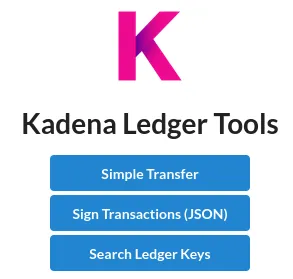
How to sign Kadena JSON Transactions with Ledger
This feature is intended for intermediate to advanced users. It enables sending and receiving safe transfers using your Ledger, as well as a plethora of other complicated transactions, but it does require operating on the “JSON Transaction” level. Chainweaver may come in handy for creating these.
The Kadena Sign with Ledger page allows you to paste a JSON transaction and sign it using your Ledger. This is *not *the same as blind signing a hash! All details of the transaction will be displayed on your device.
In Chainweaver you can find your transaction in JSON format in the “Signatures” page, after expanding “Advanced Details and Signing Data”. The “JSON” tab should be pre-selected.
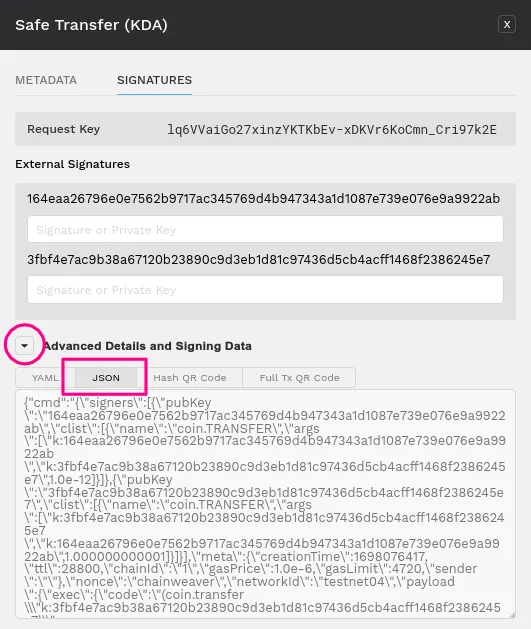
Copy the entire text field starting with {“cmd”:”{\”signers\”: and paste it in the large text area on the Sign with Ledger tool.

After clicking “Sign with Ledger” you will see all relevant details of this transaction on your Ledger device. If you see Error: Nothing to sign! (...) Do you need to select a different account? then you may be helped by the “Ledger: Search keys” section of this article.
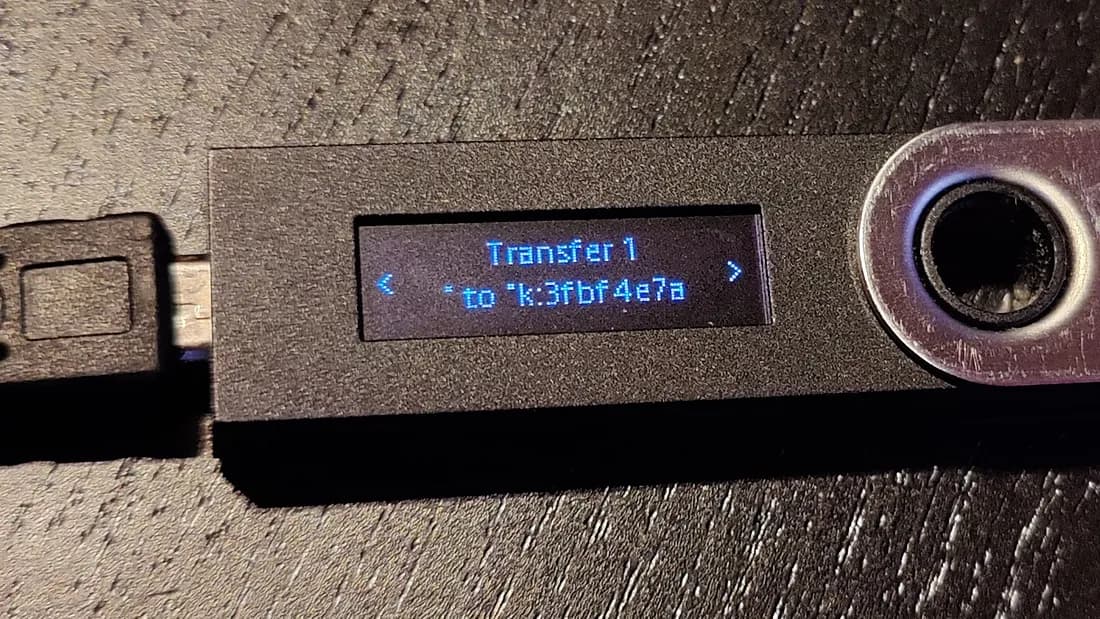
When signing on a Ledger device, you should always check the details of the transaction carefully. If everything is in order, click “Confirm” to sign the transaction. After this, the Transfer Tool should update its interface to show the transaction signature:

The signature from the ledger device is shown in the text field, and you can copy it easily with the button on the right of the signature. If there are no more signatures required, you can submit the transaction to the network directly from the tool.
In certain cases, such as when signing one part of a safe transfer, more signatures will be required before the transaction can be submitted. In this case, the interface will look like this:
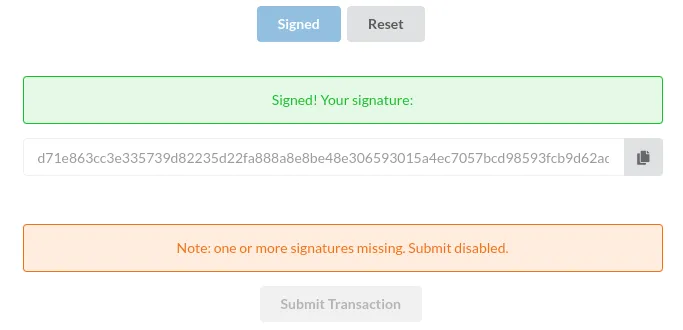
The signature will be available to copy as before, but submitting the transaction will be disabled.
If you used Chainweaver to construct the transaction, you can copy the signature and paste it in the correct field in Chainweaver under your key in the “External Signatures” section:
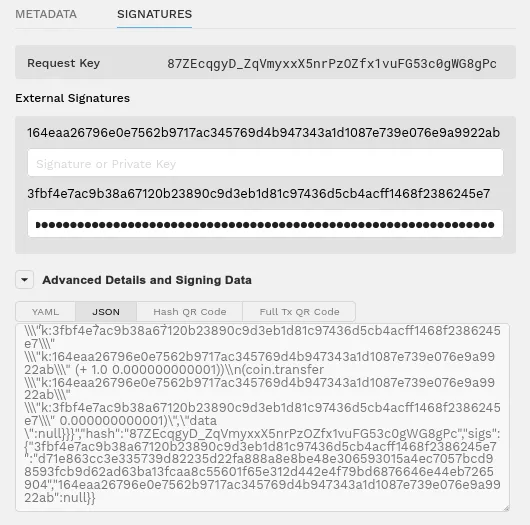
Chainweaver will validate the signature and, if it is valid, add it to the JSON transaction. You can then share the transaction JSON with your counterparty, and they should be able to sign and submit it. If the signature was invalid, Chainweaver will indicate so near the signature field.
Ledger: Search Chainweb Keys
Ledger devices support multiple accounts for most cryptocurrencies. The Kadena Ledger app is no exception, allowing an infinite amount of keys to be derived and used. The Kadena Search Ledger Keys tool allows you to search through your available keys to find a specific key or a desired prefix.
The default Ledger key/account that you’d use without customization will usually be “key zero”, or the first key in the infinite numbered list of keys you can use.
*🤓 *How does this work? These keys are addressed using a “key derivation path”. In Kadena’s case, this path looks like: 44'/626'/0'/0/0. The 0' in the middle of this sequence is the account index, so this path would represent the first account you can use, at slot zero. The second account you can use would be derived from the path 44'/626'/1'/0/0, and so on. You can use keys in any order. The keys are derived from a master secret and cannot be linked to each other without knowing the master secret. This derivation path changed with this release, but the previous addressing method is still available in Legacy mode. Read the section “Multiple Ledger Accounts: New Standard and Legacy mode” for more details.
The Ledger simple transfer tool was recently updated to add access to multiple Ledger account keys:
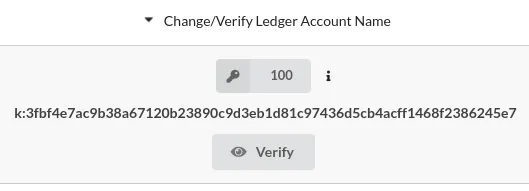
In the image, the user selected key 100 and its address k:3fbf4e7ac… was fetched from the Ledger and displayed. Clicking “verify” would show the address on the Ledger itself, which is a secure way to verify that the address was not tampered with by the website or any malware.
The new Sign (JSON) with Ledger tool also has the same support for multiple accounts, and we have extended account support in both ledger tools: the previous version “only” supported the first thousand keys, and now you can use any number.
What was my key index, again?
In case you forget which key index corresponds to which account, the Search Ledger Keys tool allows you to search your ledger for a specific key:
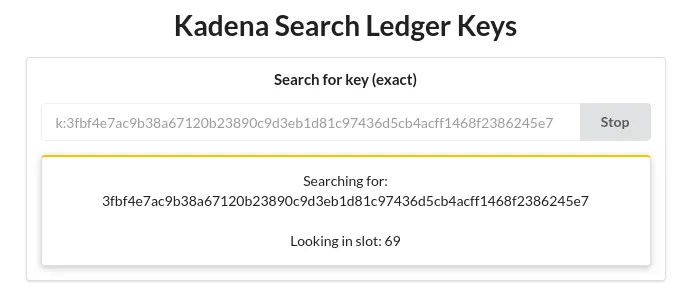
Under the hood, the tool checks each key starting with 0. Each check can take up to one second to execute, so it could be a few minutes until the key is found.
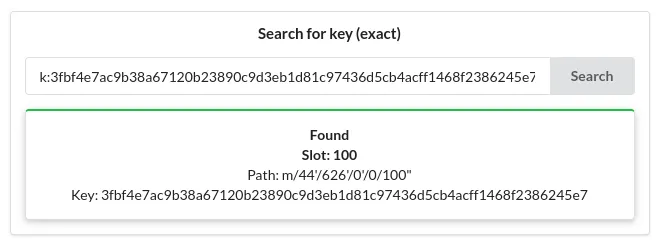
In the above example, the tool found this key at index 100. To use this key with either of the Ledger tools we would input 100 in the “Change Ledger Account Name” field.
The search tool also supports “Legacy Mode”. If you used the Ledger simple transfer feature with a custom account in October 2023, you should be able to find your keys and transact by toggling “Legacy Mode” on. Read the “Multiple Ledger Accounts: New Standard and Legacy mode” section below for more details about this change.
Search for key prefix
The second panel of the Search Ledger Keys tool allows you to find keys matching a specific prefix (or number of prefixes.)
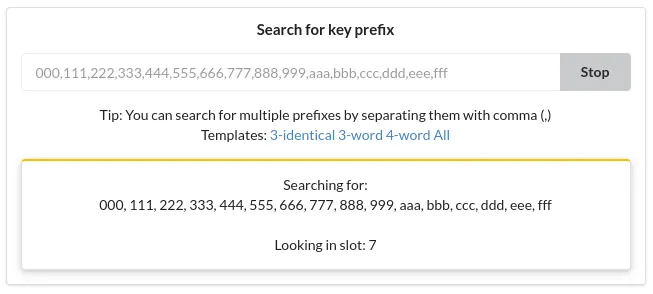
This can be used to find a key starting with a hexadecimal prefix of your choosing.
Disclaimer: keys with large offsets may not be supported by wallets.
**Stay safe: when validating that you are sending to the right account, it is important to confirm the entire key. **Checking just the first few characters may lead to you inadvertently sending funds to a malicious phishing account that is made to look similar to yours. Phishing attacks are common in blockchain, and transactions are irreversible.
Multiple Ledger Accounts: New Standard and Legacy mode
This release changes the transfer tools’ default behavior when accessing multiple Ledger accounts, but we will still support the previous method for users who have used this feature already.
If you used the “Change Ledger Account” feature in October 2023, you will be able to access your account keys using the “Legacy Mode” toggle that is now found below the “Verify” button:
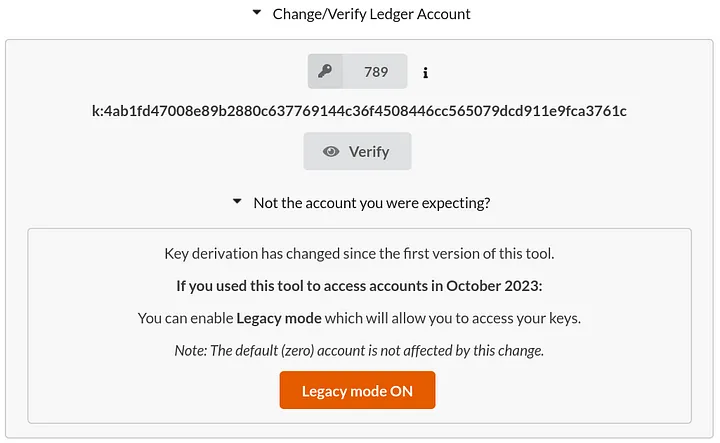
Click on > Not the account you were expecting? to expand the legacy mode panel.
All three Ledger tools on the transfer tools website have been updated to support both methods.
As always, we are extremely grateful for our community's unwavering support and feedback, and hope that you are as excited as we are with our new features!

